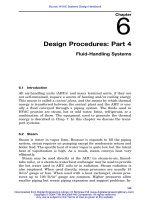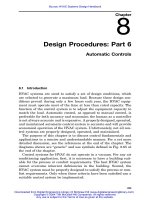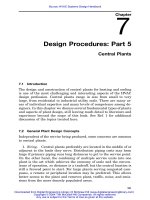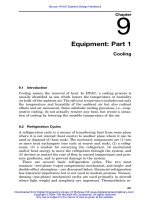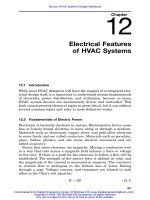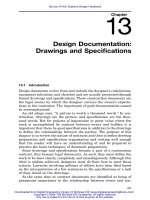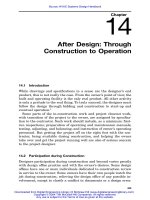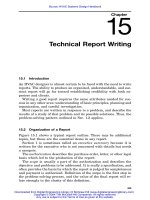HVAC Systems Design Handbook part 7
Bạn đang xem bản rút gọn của tài liệu. Xem và tải ngay bản đầy đủ của tài liệu tại đây (287.11 KB, 32 trang )
191
Chapter
7
Design Procedures: Part 5
Central Plants
7.1 Introduction
The design and construction of central plants for heating and cooling
is one of the most challenging and interesting aspects of the HVAC
design profession. Central plants range in size from small to very
large, from residential to industrial utility scale. There are many ar-
eas of individual expertise and many levels of competence among de-
signers. In this chapter we discuss several fundamental types of plants
and aspects of plant design, still leaving much detail to literature and
experience beyond the scope of this book. See Ref. 1 for additional
discussion of the topics treated here.
7.2 General Plant Design Concepts
Independent of the service being produced, some concerns are common
to central plants.
1. Siting. Central plants preferably are located in the middle of or
adjacent to the loads they serve. Distribution piping costs may loom
large if primary piping runs long distances to get to the service point.
On the other hand, the combining of multiple service units into one
plant is the act which achieves the economy of scale and the conven-
ience of operation, so distance is a tradeoff, but the central location is
still a favored point to start. For large plants serving congested cam-
puses, a remote or peripheral location may be preferred. This allows
better access to the plant and removes plant, traffic, noise, and emis-
sions from the more densely populated areas.
Source: HVAC Systems Design Handbook
Downloaded from Digital Engineering Library @ McGraw-Hill (www.digitalengineeringlibrary.com)
Copyright © 2004 The McGraw-Hill Companies. All rights reserved.
Any use is subject to the Terms of Use as given at the website.
192 Chapter Seven
For high-rise buildings, there is the question of the basement, roof,
or in between. On-grade locations have the best access. Sometimes
buildings are occupied from the ground up during extended construc-
tion, suggesting a low-level site. Where water systems are involved,
pressures may become very high at lower building levels. This is less
of a problem with chillers than with boilers. Systems with boilers often
take the equipment to the roof, partly for pressure considerations,
partly to eliminate the problem of taking the flue up through the
building, partly for emission dispersion. Cooling towers need to be
near the chiller served if possible, to reduce the cost of piping, but the
cooling-tower vapor plume can be a problem in cool weather if it im-
pacts the building (window cleaning, condensation on structure, etc.).
A vapor plume is a cold-weather visual problem in year-round opera-
tion and may cause a local ‘‘snow’’ effect in cold climates.
2. Structure. The enclosure and support for major plant equip-
ment should be strong enough to withstand vibration, to support
equipment and piping, to contain yet accept expansion and contrac-
tion, to enclose and subdue noise, and to support maintenance through
access and hoist points.
In some environments, plant structures are fully enclosed by heavy
masonry. In the industrial environment, in mild climates, plant struc-
tures may be open, offering only a roof and access, possibly a sound
enclosure. Some well-designed plants may take on an aesthetic aspect
including large expanses of glass and careful lighting. It is a fun ex-
perience to sculpt in pipe and equipment for all to see. This can be
accomplished with little premium construction cost, but it takes more
design time and an artist’s inclination. Some feel that a plant that
looks good may work better, since more time is given to function and
layout than in the ‘‘quick and dirty’’ arrangements so often encoun-
tered. Well-arranged plants usually are more easily maintained, given
the space associated with form and symmetry.
As a general note, reinforced-concrete floors and below-grade walls
have proved to be durable. Steel-frame superstructures with inter-
mediate floors of concrete and steel work very well. Steel members
with grating for walkways are very popular.
Plant enclosures should allow for future equipment replacement or
addition, with wall openings and possibly roof sections which can be
removed and replaced.
3. Electrical Service. Many plants, particularly those with chillers
or electric boilers, comprise a major electrical load for the facility.
Proximity to the primary electrical service is a cost concern. The elec-
trical service should be well thought through, and should allow for
any projected plant expansion, if not in present gear, at least in space
and concept. Since the plant environment may be coarse (although
Design Procedures: Part 5
Downloaded from Digital Engineering Library @ McGraw-Hill (www.digitalengineeringlibrary.com)
Copyright © 2004 The McGraw-Hill Companies. All rights reserved.
Any use is subject to the Terms of Use as given at the website.
Design Procedures: Part 5 193
cleanliness is a virtue), electrical equipment is often housed in a sep-
arate room with filtered, fan-forced ventilation. Some electronic gear
needs to be in an air conditioned space.
Where many motors are involved in a plant, motor control centers
(MCCs) are preferred to individual combination starters. Large plants
may have several MCCs to reduce the length of wiring runs.
The electrical service should have a degree of redundancy. Hospitals
and other critical-care facilities require access to at least two inde-
pendent utility substations. This carries into the large plant in the
form of multiple transformers and segmented switch groups with tie
breakers. Standby power generation may be included in plant design
in addition to backup power for life safety issues.
4. Valving. In central plants there is no substitute for isolation
valves for every piece of equipment. Multiple high-pressure steam
boilers require double valving with intermediate vent valves to protect
workers inside a unit that is down for maintenance. Valves should be
installed in accessible locations.
7.3 Central Steam Plants
Some general concepts of steam distribution were presented in Chap.
6. Steam plants require considerations of siting, structure, and elec-
trical service, as described in this chapter. Boilers are the primary
component of steam plants and are supported by a host of auxiliary
components such as boiler feed pumps, deaerating feedwater heaters,
condensate holding tanks, water softeners, blowdown heat recovery
systems, water treatment systems, flue gas economizers, fuel-handling
equipment, etc. See Fig. 7.1.
Each component of the steam system is available in a range of qual-
ity and performance characteristics. Selection depends on duty and on
the sophistication of the plant operation. Equipment for a smaller
school will be of a different character than for a campus or an indus-
trial plant. With all the subjective differences, the technical calcula-
tions are similar.
Because condensate originates in heat exchange devices as a fluid
without pressure, it must drain by gravity to a collection point. If a
steam plant can be located at the low point of the served system, the
entire condensate return line may flow by gravity. Otherwise, inter-
mediate collection points and booster pumps may be required.
An important aspect of a steam plant is the condensate storage ves-
sel. When a boiler fires up after a time of setback or at the onset of a
peak heating load, a significant amount of feedwater will be evapo-
rated and sent out into the system with a time lag before any of the
condensate will get back to the plant. The storage tank must hold
Design Procedures: Part 5
Downloaded from Digital Engineering Library @ McGraw-Hill (www.digitalengineeringlibrary.com)
Copyright © 2004 The McGraw-Hill Companies. All rights reserved.
Any use is subject to the Terms of Use as given at the website.
194 Chapter Seven
Figure 7.1
Steam plant diagram.
enough water to sustain the initial demand, and then it must have
enough ‘‘freeboard’’ or residual capacity to accept the returning con-
densate after an evening load shutdown. Failure to provide adequate
storage is observed through storage tank overflow, with high makeup
water rates and high treatment costs.
Small plants often use the feedwater heating tank as a combination
storage-and-preheat vessel.
Most steam plants use a version of a feedwater heater to remove
dissolved oxygen by bringing the feedwater to the boiling point. This
also tempers the water to reduce the potential for damaging the boiler
with a shot of cold water.
Feedwater makeup to boilers is accomplished with feedwater
pumps. If feedwater is heated to near the boiling point, the pumps
must have a low net positive suction head (NPSH) to avoid cavitation.
Small plants often have a dedicated pump for each boiler with a level
control on the boiler drum which cycles the pump on a call for more
water. Larger plants usually have a continuously running pump for
several boilers with modulating valves and automatic level controls to
maintain a constant level in the boiler steam drum.
7.3.1 Steam plant controls
In a very small steam system, a space thermostat may cycle the boiler
on and off, and the steam drum-level control will activate the feed-
Design Procedures: Part 5
Downloaded from Digital Engineering Library @ McGraw-Hill (www.digitalengineeringlibrary.com)
Copyright © 2004 The McGraw-Hill Companies. All rights reserved.
Any use is subject to the Terms of Use as given at the website.
Design Procedures: Part 5 195
water pump. In a more complex system, the boiler(s) will maintain a
constant steam pressure in the main header, and a pressure control
will modulate the fuel input to match the load. For multiple-boiler
operation, there may be a plant master control which will apportion
the load to the several boilers on a proportional or a programmed
basis.
7.3.2 Flue gas economizers
Flue gas economizers are often used on steam boilers to pick up an
additional 3 to 7 percent of combustion efficiency. Reclaimed heat from
the economizers may be used for combustion air preheating or feed-
water preheating. In either case, care must be taken to keep the ex-
iting flue gas above the water vapor condensation temperature, and
for feedwater heating, there must be adequate flow to avoid steaming
in the economizer.
7.3.3 Boiler testing
It is often desirable or necessary to test steam boiler performance. To
this end, a valve to open for discharge to atmosphere is included in
the plant design. The test valve discharge line should include a sound
silencer to minimize the noise.
7.4 Central Hot Water Plants
Some general concepts of heating water distribution were discussed
in Chap. 6. Chapter 10 discusses boilers and some other pieces of heat-
ing plant equipment.
Low-temperature water (LTW) heating systems (150 to 250ЊF) are
simple in design. They include boiler(s), pump(s), and secondary com-
ponents such as water treatment, air eliminators, and expansion
tanks. See Fig. 7.2. The simplicity of these systems is compelling. They
become so automatic and reliable that even in larger sizes they are
often taken for granted.
Most hot water plants serve loads of varying magnitude. If constant-
flow systems were common in the past, variable-flow systems are be-
coming more common because of the reduced pumping energy which
can be obtained at lower loads.
Water heating plants are usually designed for a heating differential
of 20 to 40ЊF through the boilers. Return water temperatures below
140ЊF to the boiler should be avoided in most cases out of concern for
flue gas vapor condensation and for ‘‘cold shock’’ of the boiler itself.
Multiple hot water boilers are almost always piped in parallel. See
Figs. 7.3 and 7.4. Where two boilers are selected, it is common to size
Design Procedures: Part 5
Downloaded from Digital Engineering Library @ McGraw-Hill (www.digitalengineeringlibrary.com)
Copyright © 2004 The McGraw-Hill Companies. All rights reserved.
Any use is subject to the Terms of Use as given at the website.
196 Chapter Seven
Figure 7.2
Elementary heating water system diagram.
Figure 7.3
Central heating plant, multiple boilers / common pumps.
each for 60 percent of the peak load, to allow one boiler to keep the
system ‘‘alive’’ if the other boiler fails. For a three- or four-boiler or
more system, boilers are usually sized so that the entire load can be
carried even if the largest boiler fails. There is usually a smaller boiler
sized to the summer load. Care must be taken not to underestimate
Design Procedures: Part 5
Downloaded from Digital Engineering Library @ McGraw-Hill (www.digitalengineeringlibrary.com)
Copyright © 2004 The McGraw-Hill Companies. All rights reserved.
Any use is subject to the Terms of Use as given at the website.
Design Procedures: Part 5 197
Figure 7.4
Central heating plant, multiple boilers / individual pumps.
the peak summer demand. Undersizing the small boiler forces the use
of a larger boiler, losing the benefit of the smaller selection.
Water heating plants usually have a means of introducing an oxygen
scavenging chemical with corrosion inhibitor to the system. Soft water
is often used for fill water. Heating water systems should be quite
tight, requiring little makeup water. Where glycol solutions are used
for freeze protection, a means of introducing the glycol-water mixture
must be included in the plant. This often takes the form of a holding
tank with a feed pump. Glycol solutions require attention to materials
in the system. Some elastomers are sensitive to some petroleum-
derived glycols.
Feedwater should be introduced to the system through a pressure-
reducing valve, set for a pressure below the maximum operating pres-
sure of the boiler.
7.5 High-Temperature Hot Water Plants
High-temperature water (HTW) plants usually have supply water
temperatures between 350 and 450ЊF. This discussion also includes
plants with a supply temperature between 250 and 350ЊF because the
principles are similar. These systems became popular in the post-
World War II era, as an alternative to steam plants for large campus
and military-base central heating systems. The advantage is related
to the ability of water with high temperature differential to move large
quantities of heat in smaller distribution pipe. Pumping and control
may be simplified. System design pressures are similar as for high-
Design Procedures: Part 5
Downloaded from Digital Engineering Library @ McGraw-Hill (www.digitalengineeringlibrary.com)
Copyright © 2004 The McGraw-Hill Companies. All rights reserved.
Any use is subject to the Terms of Use as given at the website.
198 Chapter Seven
pressure steam, but must be handled carefully to avoid flashing re-
lated to changes in elevation across the facility.
The detailed design of HTW plants is a specialty beyond the scope
of this book. There are few definitive works on the technology and only
a few design offices across the country, with personnel having HTW
experience. Chapter 14 of the 2000 ASHRAE Handbook, HVAC Sys-
tems and Equipment, discusses the topic.
A designer working in or with an HTW plant will find recognizable
components. High pressure boilers are the heart of the plant. Almost
any fuel can be accommodated. HTW boilers are almost always cir-
culated with constant flow independent of the load, to avoid hot spots
and steaming on the heat transfer surfaces. Some plants use a large
drum with a steam cushion to accept the wide fluid expansion and
contraction episodes encountered in large systems. An alternative and
now more common practice is to use an expansion drum pressurized
with nitrogen in a manner similar to a conventional lower-temper-
ature heating plant.
HTW plants usually serve variable-flow secondary systems (the
loads have control valves which meter the supply water to match the
load) and therefore benefit from variable-speed control for the system
pumps.
To protect the plant from power outage, most HTW plants have
standby power generation capability. To protect from sudden water
loss due to rupture in the distribution system, quick-closing valves on
the piping in and out of the plant are recommended.
HTW plants usually look for return water temperatures ranging
from 200 to 250ЊF. If the water comes back warmer than the design
value, it becomes difficult to load the fixed-circulation-rate boilers.
Building system designers working with HTW should recognize that
steam generation at pressures above 15 lb/in
2
is not a good load for
an HTW system. Since the HTW leaving the steam generator must be
above the steam saturation temperature, it is impossible for a steam
generator to get the return water temperature down to the plant de-
sign inlet condition. Large HTW flows are required, and this wastes
distribution system capacity. This problem can be relieved by cascad-
ing the steam generator HTW return into a lower-grade heating ser-
vice; but, in general, high-pressure steam requirements should be ac-
commodated with an independent boiler.
7.6 Fuel Options and Alternative Fuels
A nice feature of central heating plants is that if the load requirements
are not extreme, almost any fuel source can be utilized to make steam
or hot water. Coal, oil, and gas (natural, liquefied, manufactured) are
Design Procedures: Part 5
Downloaded from Digital Engineering Library @ McGraw-Hill (www.digitalengineeringlibrary.com)
Copyright © 2004 The McGraw-Hill Companies. All rights reserved.
Any use is subject to the Terms of Use as given at the website.
Design Procedures: Part 5 199
traditional fuels. But wood refuse, combustible by-product, and mu-
nicipal and industrial waste and industrial process exhaust streams
are all candidates for central plant heating sources. Under some con-
ditions, electricity may be used as an energy input for a central plant.
High-temperature geothermal waters or steam can be used through
heat exchangers for central heating. Direct use of many geothermal
resources incurs problems with corrosive and precipitate aspects of the
waters.
Solid fuels present design challenges related to delivery, handling
and storage of the input fuel, and the collection, storage, and disposal
of the residual matter. Still, there may be appropriate applications for
coal, wood, bagasse, or refuse-derived fuels (RDF).
7.7 Chilled Water Plants
Central chilled water plants for HVAC systems have evolved to a com-
bination of factory-built chillers and pumps in a variety of piping and
pumping configurations. Since the cooling effort may require a large
amount of energy to drive the process, much attention is given to
schemes which reduce energy use. In some office space cooling ser-
vices, the cooling function may be considered noncritical and subject
to a low initial and operating cost design concept. In other applications
such as computer rooms and electronics manufacturing, the product
may have such high value and the quality of product may be so sen-
sitive to environmental conditions that no expense will be spared to
provide reliable cooling.
Interestingly, systems which have low operating cost may be quite
reliable because it takes better equipment and better arrangements
to operate with less energy input, assuming proven technology in the
equipment design.
There are several key factors in designing a quality chilled water
plant:
Ⅲ
Well-configured chiller(s)
Ⅲ
Efficient pumps
Ⅲ
A good piping scheme with ample valving
Ⅲ
A good control concept
Ⅲ
Good access for maintenance and replacement
Chillers as a piece of equipment are discussed in Chap. 9. Pumps
are discussed in Chap. 6, as are several piping schemes.
There is an old saying: ‘‘Pump out of a boiler and into a chiller.’’
While this is not a hard-and-fast rule, it has some basis in good prac-
Design Procedures: Part 5
Downloaded from Digital Engineering Library @ McGraw-Hill (www.digitalengineeringlibrary.com)
Copyright © 2004 The McGraw-Hill Companies. All rights reserved.
Any use is subject to the Terms of Use as given at the website.
200 Chapter Seven
Figure 7.5a
Constant (or variable) volume system without control valve.
tice. Pumping out of a boiler places the boiler at the pump suction,
which is the lowest pressure point in the system. This allows any
dissolved air to work its way out at that point. It lets the boiler be
designed for and work at no more than the fill pressure of the system.
Pumping through the chiller makes the chiller, which typically has
a relatively high (10- to 20-ft) pressure drop, the first pressure-drop
device in the system. This reduces the remaining pressure throughout
the system. Chiller heat exchangers (tube bundles) are usually rated
for 150 lb/in
2
gauge working pressure and are not threatened by the
condition.
7.7.1 Central plant piping configurations
for water
The design challenge in the central plant arrangement is to deliver
service to the distribution system while operating the plant as effi-
ciently as possible. Variations in load have more impact on chillers
than on boilers, so the following discussion will concentrate on chiller
plants. Most that is said also applies to heating plants.
Ⅲ
The simplest chilled water system (Fig. 7.5a) is that of a single
chiller with a chilled water circulating pump connected to a single
load. The system can operate without a control valve at the load, if
the load control point sensor is used directly to control chiller load-
ing; or, a variable-speed drive on the pump may be used with speed
controlled by the load sensor. Chiller flow rate variations down to
50 percent or less of maximum are possible. Chillers are also avail-
able with variable-speed drives for capacity control. Variable speed
Design Procedures: Part 5
Downloaded from Digital Engineering Library @ McGraw-Hill (www.digitalengineeringlibrary.com)
Copyright © 2004 The McGraw-Hill Companies. All rights reserved.
Any use is subject to the Terms of Use as given at the website.
Design Procedures: Part 5 201
Figure 7.5b
Constant volume pumping system.
may also be used on cooling-tower fans and condensing water
pumps. Such a simple system may seldom be found, but it illustrates
the use of variable speed in all the system elements for energy con-
servation.
Ⅲ
In an elementary system with one chiller and one or more air-
handling unit (AHU) coils, the layout shown in Fig. 7.5b works best.
The goal is to provide essentially constant flow through the chiller
while modulating flow through the AHU coils. The three-way control
valves accomplish this.
In the past, chiller manufacturers required that the water flow
rates through the chiller should be essentially constant. As return
water temperature increased, the chiller capacity was varied by in-
let vane damper throttling at the compressor intake. Present-day
systems vary compressor speed to adjust capacity to as low as 20
percent of maximum. In the constant chilled water flow system,
shown in Fig. 7.5b, the three-way valves at the loads are modulated
by the space temperature sensor/controller to match the zone load.
This will tend to increase the return water temperature, causing the
Design Procedures: Part 5
Downloaded from Digital Engineering Library @ McGraw-Hill (www.digitalengineeringlibrary.com)
Copyright © 2004 The McGraw-Hill Companies. All rights reserved.
Any use is subject to the Terms of Use as given at the website.
202 Chapter Seven
chiller control to reduce capacity until, at some low limit of capacity,
the chiller will shut down, though chilled water flow will continue.
The potential chiller cycling can be offset to some extent by raisng
the supply water temperature as the load decreases, but too great
a rise might make it impossible to maintain a desired humidity level
in the building. The pump and chiller must run continuously as long
as cooling is required. Hot gas bypass is sometimes used to force a
chiller to say on-line in low-load conditions.
Ⅲ
In any system with two or more chillers, the situation becomes more
complex, with potential operating difficulties, but with greater op-
portunities for energy conservation. Figure 7.6 shows one possible
arrangement. The first necessary step is to use two-way valves for
control of the AHU coils. If three-way valves are used, then the
system tends to require constant flow through all pumps and chillers
and little or no energy conservation is possible. Either the flow rate
or temperature control varies with the number of chiller-pump com-
binations on-line. With two-way valves, the distribution system flow
can vary in proportion to the load.
It is also possible to modulate flow rates through the individual
chillers between limits established by the manufacturer. Changes in
flow rates must be gradual, to avoid refrigerant surge. The modu-
lation may be accomplished by variable-speed pumping—best for en-
ergy conservation—or by means of throttling valves. To maintain
the required minimum flow through the chiller at reduced loads, it
is usually necessary to bypass some flow in the distribution system.
The bypass valve is controlled to maintain a constant pressure
differential between supply and return mains, sufficient to serve the
most remote AHU. This valve is frequently located in the central
plant but is better located at the hydraulically most remote load in
the distribution system. If this load is satisfied, all other loads will
be satisfied. In a very large system, several remote points may be
sampled and the most demanding used for the differential pressure
control.
The bypass valve must be sized for the nominal flow rate of one
chiller. As the load and distribution flow decrease to the point where
the valve is fully open (or nearly so), a limit switch and alarm light
can be used to inform the plant operator that one chiller and pump
can be taken off-line. When the bypass valve is fully closed (or
nearly so), a similar alarm signals the operator to start a pump and
chiller. This avoids the operating cost of unnecessary equipment and
allows the on-line equipment to operate more efficiently. The annual
saving in pumping cost alone can be very significant. The distribu-
tion system can be any of the three types discussed in Chap. 6.
Design Procedures: Part 5
Downloaded from Digital Engineering Library @ McGraw-Hill (www.digitalengineeringlibrary.com)
Copyright © 2004 The McGraw-Hill Companies. All rights reserved.
Any use is subject to the Terms of Use as given at the website.
